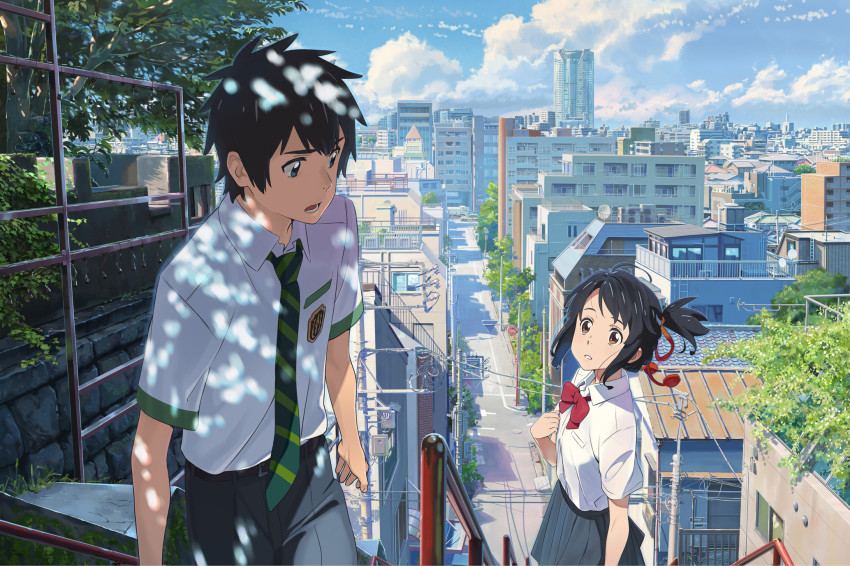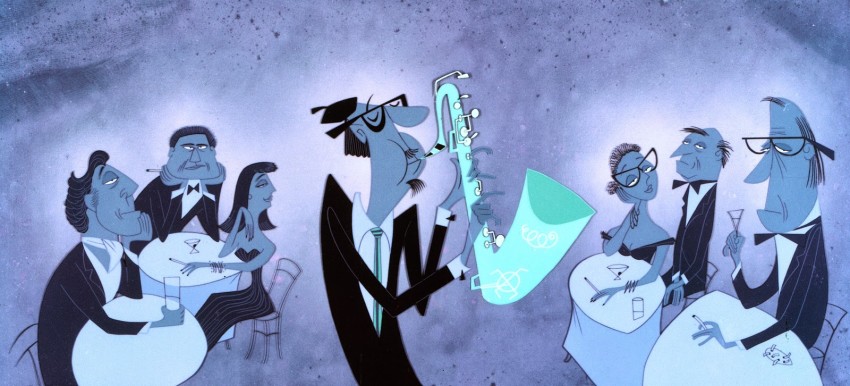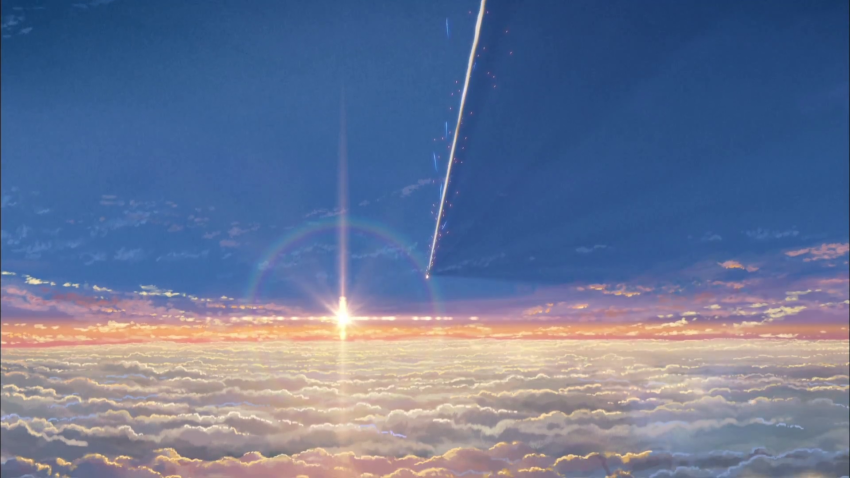Your Name Goes IMAX
September 2, 2017 · 0 comments
By Jasper Sharp.
 Japan’s biggest global hit just got even bigger this year, as Your Name became the first ever anime to receive the IMAX treatment. The new giant-screen version premiered in Tokyo back in January, extending the theatrical shelf-life of a film that had already long ridden high at the domestic box office since its original release in August 2016. The second coming of Makoto Shinkai’s body-swapping fantasy on IMAX screens across the UK presents a good opportunity to consider what exactly is signified by this brand name, Japan’s own part in the format’s history, and the role of technology in animation more generally.
Japan’s biggest global hit just got even bigger this year, as Your Name became the first ever anime to receive the IMAX treatment. The new giant-screen version premiered in Tokyo back in January, extending the theatrical shelf-life of a film that had already long ridden high at the domestic box office since its original release in August 2016. The second coming of Makoto Shinkai’s body-swapping fantasy on IMAX screens across the UK presents a good opportunity to consider what exactly is signified by this brand name, Japan’s own part in the format’s history, and the role of technology in animation more generally.
Animation has always embraced new developments in screen and sound. After all, the kind of realism created by animators is very much constructed, not recorded from reality. Disney adopted the three-strip Technicolor process early on for its Silly Symphonies series of shorts, with Flower and Trees (Burt Gillett, 1932) becoming the first full-colour film to be released commercially, several years before the live-action feature, Becky Sharp (1935), and Disney’s own landmark colour feature, Snow White and the Seven Dwarfs (1937).
While Snow White was not to be seen in Japan until 1950, the Silly Symphonies films were released at roughly the same time as in North America, and therefore count as the first full-colour animations ever to be shown in the country (note however the flickery two-colour abstraction of Shigeji Ogino’s “home movie” An Expression in 1935.
Disney’s subsequent features Fantasia (1940) and Dumbo (1941) saw it pushing its innovations into the sonic dimension (using stereophonic surround sound and synthesized sound effects respectively). One only has to compare these with Momotaro, Sacred Sailors (1945) to see just how far, on a technical level, Japanese animators lagged behind.
The next revolution came with widescreen. Fox’s CinemaScope system used anamorphic lenses to expand the picture horizontally to a ratio of 2.35:1, just short of twice the width of the standard 1.33:1 ratio. The system premiered with the live-action features The Robe and How to Marry a Millionaire in 1953, and again, Disney was an early adopter, with its short Toot, Whistle, Plunk and Boom (1953, pictured) preceding its first widescreen animated feature Lady and the Tramp in 1955.
 In this context, it is significant that Japan’s first colour animated feature, Legend of the White Serpent (1958), was also released in the widescreen ToeiScope format modelled on CinemaScope, a year after the country’s first live-action widescreen feature, The Bride of Otori Castle (1957).
In this context, it is significant that Japan’s first colour animated feature, Legend of the White Serpent (1958), was also released in the widescreen ToeiScope format modelled on CinemaScope, a year after the country’s first live-action widescreen feature, The Bride of Otori Castle (1957).
Within a matter of years, widescreen production had become the norm for all Japanese studio films, although by the 1970s, the industry’s product had largely been squeezed back to the narrower 1.66:1 ratio by the growing secondary market of television. Nevertheless, in 1980 the makers of the anime Be Forever Yamato pulled off the impressive technical flourish of expanding from the 1.66:1 ratio to 2.35:1 (and quadrophonic sound) midway through proceedings in a memorable scene that the Space Battleship Yamato journeying through a vortex into an alternate galaxy.
One drawback to anamorphic systems was that stretching the size of the image horizontally also made the film grain more visible, something particularly noticeable in early colour widescreen productions. New systems such as Todd-AO, launched with the musical Oklahoma! (1955), got around the problem by using 70mm film stock, allowing for far greater image clarity and potential projection size. Disney first used the Super Technirama 70 system, which combined 70mm with anamorphic lenses, for its production of Sleeping Beauty (1959).
The issue with these high-end formats was the specialist equipment needed to show them. In 1962, only 55 of Japan’s 6700 or so screens were capable of 70mm projection, all naturally devoted to Hollywood epics like Ben-Hur (1959) and Lawrence of Arabia (1962). Japan produced just a sparse handful of 70mm titles, starting with Daiei’s Buddha (1961), but in general the financial returns never justified the inflated expenses. Nevertheless, it is worth noting that the costs were largely shouldered on the production side, so issuing a popular anime feature like Space Battleship Yamato: Final Saga (1983) in 70mm prints with a new 6-channel sound mix to these plusher, larger venues was a commercial possibility, at least in this instance when there was a proven audience for it.
Enter IMAX. The original system had its roots in the Montreal Expo ’67, an event marked by a plethora of immersive multi-screen installations, including one called Labyrinth (1967), co-directed by Roman Kroitor and Colin Low of the National Film Board of Canada, a walkthrough piece consisting of three separate chambers, the last of which contained five screens arranged in a cruciform pattern.
 Inspired by the attention Labyrinth garnered, Kroitor assembled a team to work on a new system that used just one camera, one projector and one screen, but which ran its 70mm film prints horizontally through the projector. That system was named IMAX (contracted from “maximum image”), and it debuted at the next world fair, Expo ’70 in Osaka with the 16-minute Tiger Child (1970).
Inspired by the attention Labyrinth garnered, Kroitor assembled a team to work on a new system that used just one camera, one projector and one screen, but which ran its 70mm film prints horizontally through the projector. That system was named IMAX (contracted from “maximum image”), and it debuted at the next world fair, Expo ’70 in Osaka with the 16-minute Tiger Child (1970).
With a frame area ten times that of standard 35mm and a six-channel magnetic soundtrack supplied on a separate film strip, the new format yielded the best image definition and largest potential projection size of any single-projector system thus far. The default aspect ratio of 1.43:1 was narrower than previous widescreen systems – or rather better to say it was taller, yielding more detail at the top and bottom of the image and completely filling the vast concave screens subsequently developed for the IMAX DOME system, which encompassed the spectator’s entire visual field (although wider letterboxed projections at 1.78:1 or 1.9:1 are also possible).
However, the need for specialist cameras, projectors and screens and the system’s voracious consumption of film stock meant it was never going to take on as a serious rival to mainstream commercial exhibition. Or was it?
As an aside, Osaka Expo also hosted what must surely count as the biggest ever analogue film presentation in world history in the form of Astrorama. This utilized five interlocked 70mm projectors, which cast their images as a seamless whole onto the massive dome overhead, some 30 meters in diameter, and used 515 loudspeakers to achieve a 3D audio effect. The only film produced for Astrorama, a ten-minute work entitled The Birth featuring legendary Butoh dancer Tatsumi Hijikata, was rather clumsily lost when everything was packed away at the end of the expo, but mercifully its reels were rediscovered in 2011 – just not the hardware to play them!
IMAX, meanwhile, prevailed by establishing an alternative exhibition circuit in science parks, museums and later as standalone tourist attractions. Despite Japan’s role in hosting the world premiere of IMAX, the country’s first permanent site did not open until 1982. A number of the IMAX Corporation’s later innovations were showcased at subsequent trade fairs in Japan, such as the prototype 3D systems at the 1985 International Exposition at Tsukuba and Expo ’90 in Osaka. By 1990, Japan boasted nine out of the total 68 sites worldwide, making it second only to the United States.
The form of the films produced using IMAX were very much made to fit the format and foreground the state-of-the-art technology: travelogues and other documentary spectacles that thrust the viewer into the heart of volcanoes, sent them gliding over mountaintops and immersed them within fabulous undersea realms.
 While no bona-fide Japanese film has ever been produced using the technology, the first IMAX drama, the 40-minute Wings of Courage (1995) directed by Jean-Jacques Annaud and featuring Val Kilmer as a pilot who crashes in the Andes, nevertheless, did have a Japanese connection in that it was financed by the Sony Corporation’s American subsidiary Sony Pictures Classics. Its relatively disappointing commercial performance, linked to the limited number of venues capable of showing it, saw the company withdrawing from IMAX film production after a couple of other titles, culminating in Cirque de Soleil: Journey of Man (1999).
While no bona-fide Japanese film has ever been produced using the technology, the first IMAX drama, the 40-minute Wings of Courage (1995) directed by Jean-Jacques Annaud and featuring Val Kilmer as a pilot who crashes in the Andes, nevertheless, did have a Japanese connection in that it was financed by the Sony Corporation’s American subsidiary Sony Pictures Classics. Its relatively disappointing commercial performance, linked to the limited number of venues capable of showing it, saw the company withdrawing from IMAX film production after a couple of other titles, culminating in Cirque de Soleil: Journey of Man (1999).
And so we return to Disney, which produced the world’s first animated IMAX feature, Fantasia 2000 (1999). This millennial follow-up to the 1940 original, however, was not to prove the rousing box-office success anticipated: while it eventually earned $90 million worldwide, it cost about the same amount to make.
In May 1999, the UK’s flagship BFI IMAX opened in London (it is still the largest screen in the Britain, although the country’s first IMAX venue had opened long before at the National Media Museum in Bradford in 1983), anticipating the next phase of expansion, as commercial Hollywood features like Apollo 13 (1995), Star Wars, Episode II: Attack of the Clones (2002) and Spider-Man 2 (2004) came to be reissued in new versions converted for IMAX projection.
It should be pointed out, however, that none of these so-called “LieMAX” releases were actually filmed using IMAX cameras, but rescanned from the original 35mm negatives and optimised for IMAX screens. As such, they were of a lesser image quality than the genuine IMAX spectacles still being produced by and for the original system, like Volcanoes of the Deep Sea (2003) and James Cameron’s Ghosts of the Abyss (2003), or rare examples like Christopher Nolan’s The Dark Knight (2008), which featured a total of 30 minutes of real IMAX footage, and most recently Dunkirk.
As Paul McDonald points out in his chapter “IMAX: The Hollywood Experience” in the book Widescreen Worldwide (2010), while such “LieMAX” films might get people into IMAX cinemas to see the latest releases in optimum screening circumstances, in the longer term they have proven less profitable than the type of high-end educational films specifically made for the format, such as The Dream is Alive (1985), about the Challenger space shuttle, Everest (1998) and Hidden Universe 3D (2013), which have enjoyed more extensive runs at more traditional IMAX sites.
The issue of what actually constitutes the “authentic” IMAX experience has been further muddied by its migration away from site specific attractions and into multiplexes and, from 2008 onwards, a concurrent move to digital projection.
There are now over 30 screens across the UK, and around the same number in Japan, although many of the original science park sites have vanished to be replaced by new screens in cinema complexes such as the new Shinjuku Toho Building, which opened in Kabukicho in April 2015. It should be clear that the term IMAX no longer refers to a specific technology, but a brand name associated with giant-screen presentations of films that have often originated in a different format.
So where does all this lead us with respect to the IMAX release of Your Name?
 With Toho Cinemas signing a new deal with IMAX in 2015 to vastly expand its number of screens in Japan, it is no wonder the company would choose its most lucrative release of 2016 to fill them. However, Shinkai’s film is ultimately a modestly budgeted, small-scale affair compared with the kind of thing you might usually associate with the format. Like so many recent anime features, in terms of its line-art character designs, colouring and background detail, it sticks with the representational tropes familiarised internationally by Studio Ghibli (no wonder so many have heralded Shinkai as “the new Miyazaki”). Its 2D style of rapidly-edited compositions laid out like manga pages is the antithesis of the volumetric, vanishing-point photorealism of Disney-Pixar and their ilk. More crucially, it presents a complete rupture from the aesthetic conventions encouraged by the IMAX format itself.
With Toho Cinemas signing a new deal with IMAX in 2015 to vastly expand its number of screens in Japan, it is no wonder the company would choose its most lucrative release of 2016 to fill them. However, Shinkai’s film is ultimately a modestly budgeted, small-scale affair compared with the kind of thing you might usually associate with the format. Like so many recent anime features, in terms of its line-art character designs, colouring and background detail, it sticks with the representational tropes familiarised internationally by Studio Ghibli (no wonder so many have heralded Shinkai as “the new Miyazaki”). Its 2D style of rapidly-edited compositions laid out like manga pages is the antithesis of the volumetric, vanishing-point photorealism of Disney-Pixar and their ilk. More crucially, it presents a complete rupture from the aesthetic conventions encouraged by the IMAX format itself.
The educational films with which IMAX are most commonly identified are characterised by a prevalence of grandiose long-take, wide-angle, point-of-view travelling shots from an endlessly mobile camera as it maps out various spaces and terrains, breaking down the barrier between spectator and subject. This type of cinematic hyperrealism is also what modern blockbusters like superhero films thrive on. However, while the flat worlds of anime are often highly detailed, they can hardly be described as “realistic” in this same cinematic sense.
Nevertheless, my own experience watching Your Name on the huge screen of the Empire Leicester Square was a surprisingly rich one. There seems to have been no change in the 1.78:1 aspect ratio in the conversion to the new IMAX version, and it is true that, aside from occasional peripheral offscreen sounds, there’s not really the same sense of immersion one associates with the IMAX experience.
However, the expanded screen dimensions do encourage a more active viewer engagement. One is “immersed” in Shinkai’s world in a very different fashion, encouraged to “read” the image as one’s eyes scans across the details and artistry of its designs: quite literally as your eyes dart from the subtitles to wealth of onscreen information, with Japanese text cropping up all over the place as part of the image itself, in newspapers, cell-phone messages, and background advertisements. Indeed, one would be well advised to sit way back from the screen to take it all in. The format also exaggerates Shinkai’s use of depth-of-field and shallow focus to emphasise his main characters’ fragmented and confused subjectivity.
The very fact that Your Name is getting such tentpole treatment in the UK is cause for celebration in itself, a barometer of just how far has anime has been assimilated into mainstream culture. Certainly I can’t imagine Shinkai ever anticipated an IMAX release for his film when he embarked on its production, but while it understandably doesn’t exploit the format’s potential, it generally acquits itself well under the scrutiny afforded by its exposure on the giant screen and certainly presents a different experience than home viewing. LieMAX it might be, but it looks and sounds fantastic.
Jasper Sharp is the author of the Historical Dictionary of Japanese Cinema.
Leave a Reply